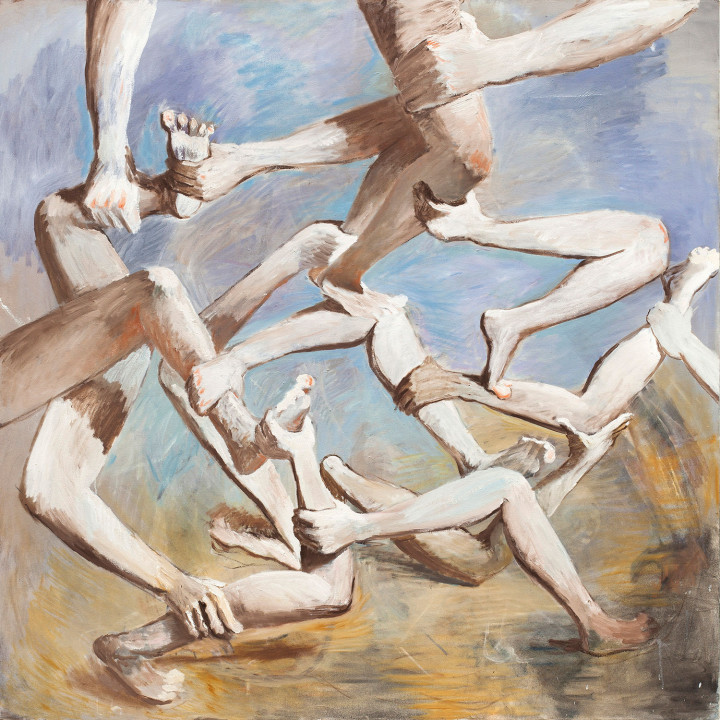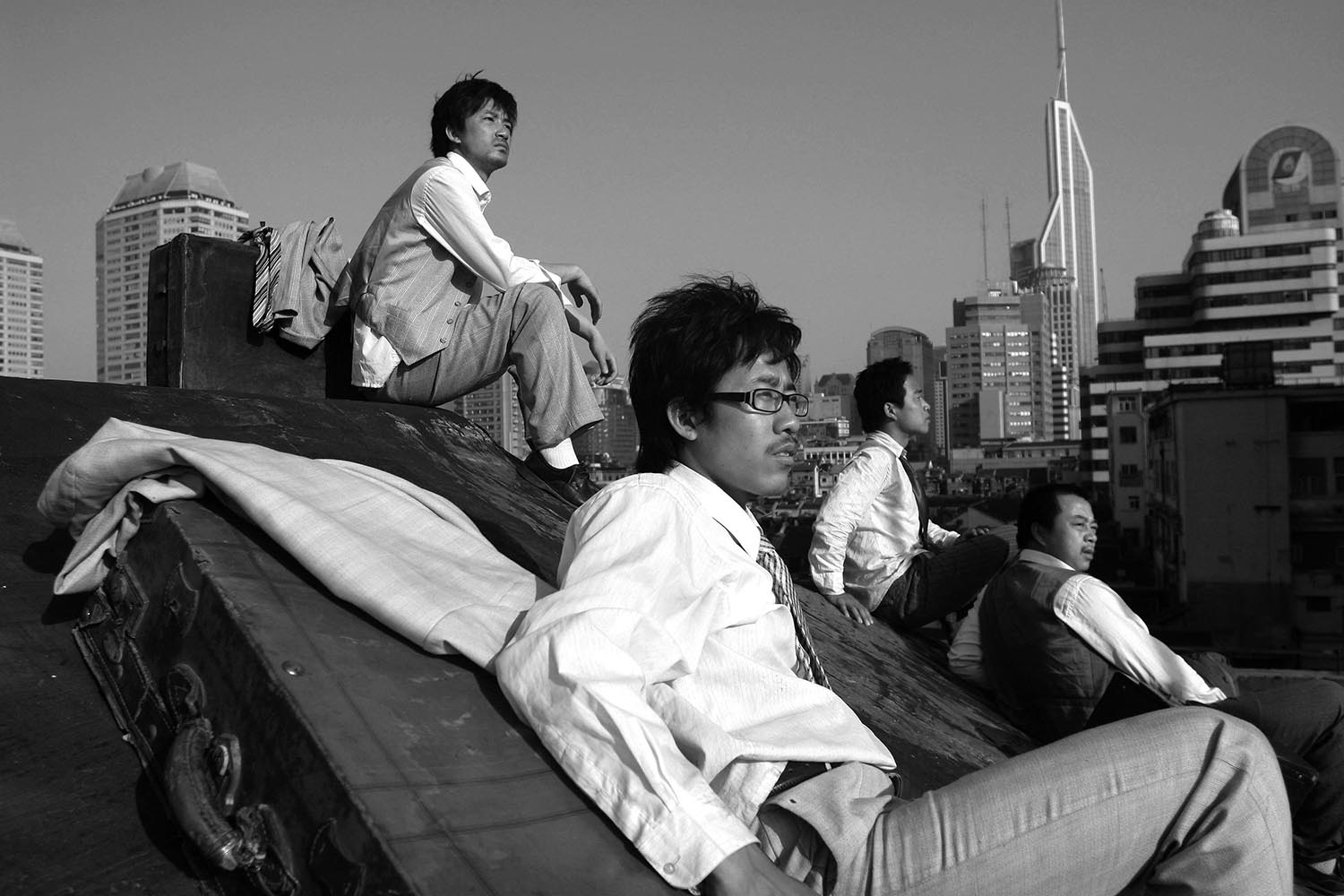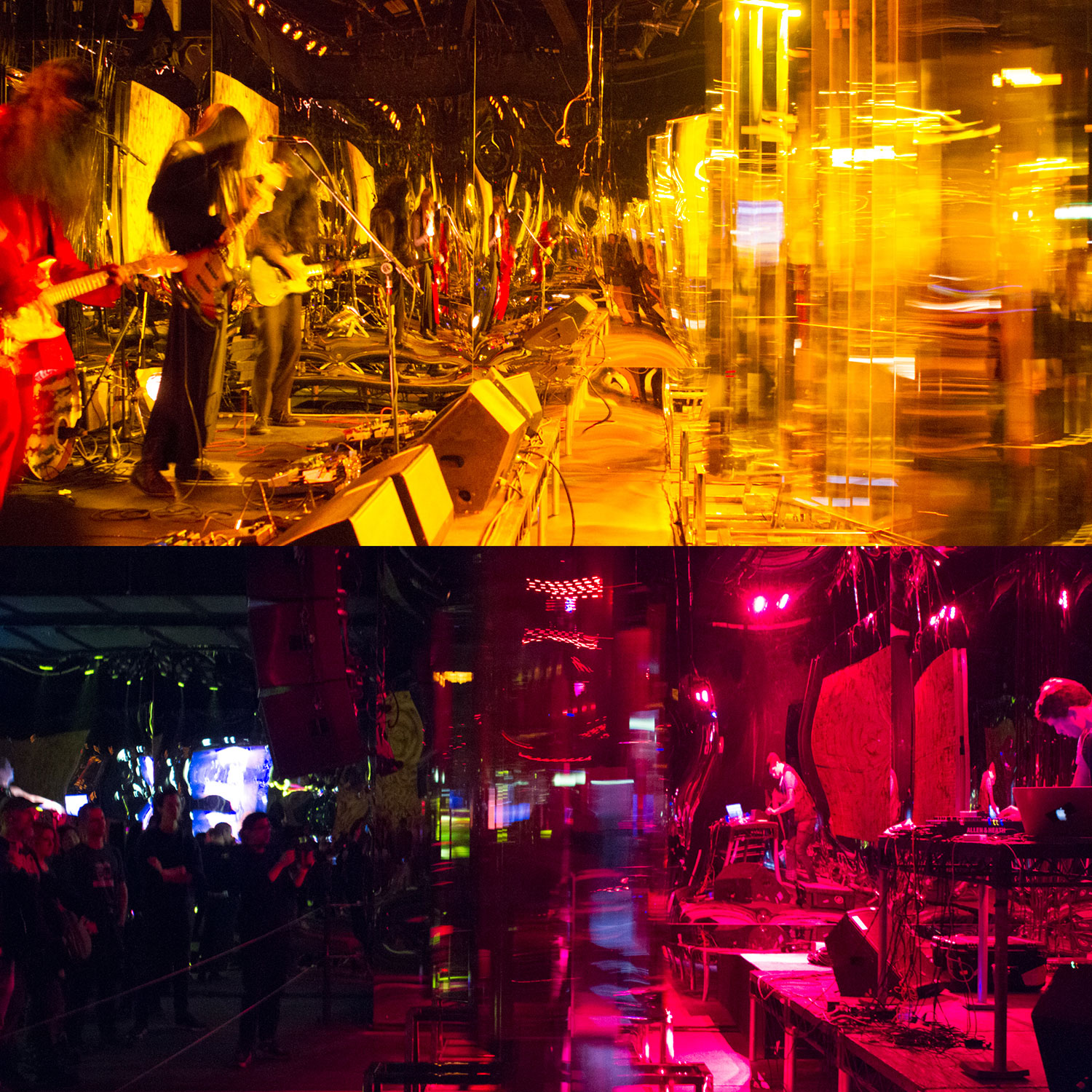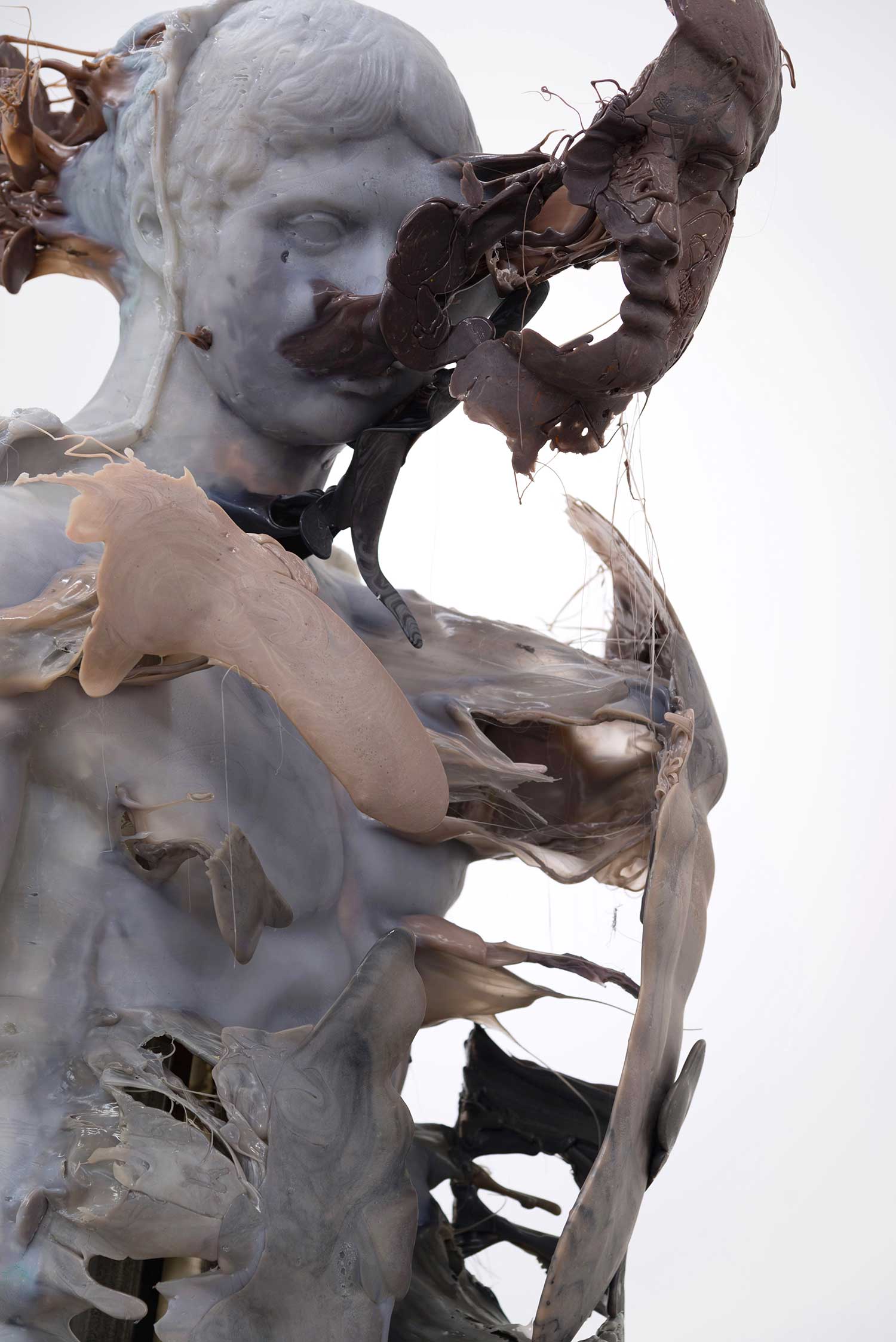
In a recent performance that took place in New York, in the context of last November’s Asia Contemporary Art Week, amid a series of lectures and conversations, Shanghai-based artist Tang Dixin (b. 1982) enacted a physical engagement with books. Balancing a hefty stack up to his forehead and moving slowly against the wall, he paved every step by dropping a book from the pile until a path formed along his struggled movement. At the trail’s end, he backtracked the same route, picking up books behind him, only to hurtle them forward as forcefully as possible. The audience — a crowd of international curators and artists — watched closely until the artist emerged from his demanding ordeal bathed in sweat. There was a captivating contrast between the precarious balancing act and the ensuing cathartic release; the plot was laid bare, yet its reading continued to ferment. What forms of struggle did his back-and-forth trips suggest? Or did they have to subscribe to symbolism? The fact that the books were never opened — except in flight and in destruction — might allude to still more, especially in the context of an overabundance of discourse and its necessary misinterpretations.
At a time when performance art grows more ambitious in scale, reference and production value, Tang’s practice calls to mind the medium’s incipient rawness wherein the physical body — whether the artist’s own or that of his willing subjects — plays a central role in minimal yet charged acts that converse pointedly with the social space of performance. For Tang Dixin, these spaces have always been specified or constructed in a thoughtful (if not kooky) manner: a makeshift clinic with distinct 1980s décor where visitors receive random plaster casts that enforce a temporary halt in productive activities (Rest is the Best Way of Revolution, 2012–13); or subway tracks on which the artist lay flat to record the bottom of a passing train during the Shanghai World Expo (Act of God, 2010). Rife with references to contemporary events and vernacular in China, these performances can bait interpretations along the lines of critique or interference. Yet more often they resonate with a sense of whim and speak to the quiet violence of the familiar, as if the purpose is not to engage with a certain social reality or a cultural identity, but to withdraw from their tyrannical hold on imagination.

This is where Tang’s (predominantly oil) painting practice, which can appear too sensitively executed to be considered alongside his performance works, finds some common ground with the latter. The comparison is not limited to the depiction of bodies and their implied utilities or abuse; while entangled, re-engineered and disembodied body parts have become a hallmark in Tang’s painterly practice, they perform much more ambiguous tasks. In Hand Hand (2013), an easel-size monochromatic work, dozens of fingers in contrasting skin tones (nude and brown) crisscross down the center of the pictorial field. The expressive animation of each finger is set off by the complete lack of anatomical logic in the areas to which they appear to be attached. In Entangled (2014), an arbitrary set of limbs — each with a joint, a hand, and a foot — grab onto each other to form a latticework against a vaguely defined background of pale violet-blue and yellow ochre.
Unlike the early twentieth-century precursors of Surrealism and Cubism, who concocted similar distortions of the human body as both probe and manifestation of the subconscious, Tang’s puzzle-work of body parts are less burdened by symbolism and often conceived just as whimsically as his performance works, as the artist frequently acknowledges in interviews. Suspended as they often are in muted settings and ambivalent temporalities, even the most absurd or brutal reconfigurations of figural motifs radiate an eerie calm, like the mutated figural mass in Thinker (2015). A recognizable homage to Rodin’s famed bronze sculpture, the crouching, pale nude figure buries his head among a cluster of disparate limbs. The forearm supporting his head is particularly prominent, measuring longer than his upper body; a few supporting legs and arms, in contrast, appear skeletal in emphatic orange and brown silhouettes, which play off the cool blue hues delineating other extremities. These bright tinges and the textured, murky purple background are almost too gorgeous for the grotesque subject being rendered. Not to be mistaken with the angsty penseur at the gates of hell, this creature seems to be an incarnate of the postmodern bogeyman: radioactively mutated yet aesthetically pleasing, and a bit bored.
Tang’s more normal-looking protagonists are not less unhinged. In Yellow Peril (2013), a young Asian (or Chinese) boy lifts the outer corners of his eyelids, reenacting a classic racist gesture. Come on Genghis Khan, painted in the same year with a childlike technique, portrays the thirteenth-century Mongolian emperor blowing up a balloon as if making a cameo on a comedy-variety show. A much earlier painting, Three Kingdoms (2008), depicts in casual yet concise brushwork three naked men forming a circle and exposing their rear ends; one of these is directed straight at us. Neither scandalous nor scandalizing, these goofy acts elude solid grasps of meaning and indexicality. After all, representation of violence, the grotesque or even the obscene could not be further from the thing itself. And the titles only seem to thicken the plot. Three Kingdoms, for instance, invites associations with a specific historical period (AD 220–280), the famous fourteenth-century historical novel, or the plethora of popular culture derived from these sources, but there’s very little to infer as to how these contexts triangulate the painting itself, with its bare figures and barren background. A more plausible association may just be the juvenile jokes painters occasionally indulge, like obscene doodles found in Dunhuang caves or the central positioning of a warrior’s genitals in battle scenes painted by Rosso Fiorentino (1495–1540). Except in Tang Dixin’s case, he seems less committed to the joke than to an incisive problematization of image production.
And what about Chineseness? There has been a kind of identity politics that’s rather performative, even exhibitionist, in its careful deployment within familiar curatorial and art-historical narratives, especially for artists working outside the Euro-American discourse. But for Chinese artists of Tang’s generation, whose sources have rapidly become much more diluted and diversified, there’s an increasing sense of indifference — not even resistance — to that very kind of narrative. The curious case with the paintings discussed above is that the titles have at best a tenuous relationship with the painted subjects, but our experiences with the paintings would have been quite different without some knowledge of these references and (perhaps also) the collective cultural experience they may evoke. If there is any sense of “Chineseness” to speak of, it no longer serves as a built-in, self-explanatory device, but rather as a knowing nod to the broader context without committing to it as such.

There’s also much more to an individual’s practice than this quickly depreciating framework. Earlier in Tang’s career, in the late 2000s, an array of thinly smeared landscapes and still objects had begun to create a world that had already faded. In that world, we might find ourselves hovering slightly above an urban rooftop littered with clothing racks and sheets; in the distance, an impending storm engulfs part of the city in thunderstorm (Rooftop, 2009). We find other gently absurd quotidian fragments, like a fire extinguisher holding a lit cigarette between its handles (Smoking Addiction, 2009), a parachute with the paratrooper submerged in thick clouds (Parachute, 2009), or an isolated skyscraper expressed in wispy shimmers of paint (Assuming Light, 2011). The childlike ease and charming lethargy with which Tang handled these paintings are sometimes redolent of the canvases of Norbert Schwontkowski, except much less dark and populated. It’s almost always a singular scene, a singular object or a singular act, as is the case with his performances.
In 2014, Tang Dixin presented a singular act titled Mr. Hungry, in which he scaled the walls of Shanghai’s AIKE-DELLARCO Gallery in mountain-climbing gear. Navigating the confining white cube with an ice axe and crampons, he maneuvered around pre-installed monitors screening footage recorded in first-person perspective of the artist crawling unconventionally in various public and private interiors, landing only when he finished the full obstacle course. As the precursor to his New York performance with books, it calibrated a similarly visceral gesture to activate an unexcavated dimension of a space — as if in search of a hidden level in a video game — that has become too familiar to be potent. One couldn’t help but think of Franz Kafka’s A Hunger Artist (1922), a short novel the artist privately acknowledges as a source for the performance title, and the possible allegories of public fasting — the waning art form practiced by the protagonist in the fiction. Perhaps for Tang Dixin, that precarious position between management of spectatorship and management of intent, between the “perversion of truth” and latent violence, between the cage and the trade, is precisely the place to be.





